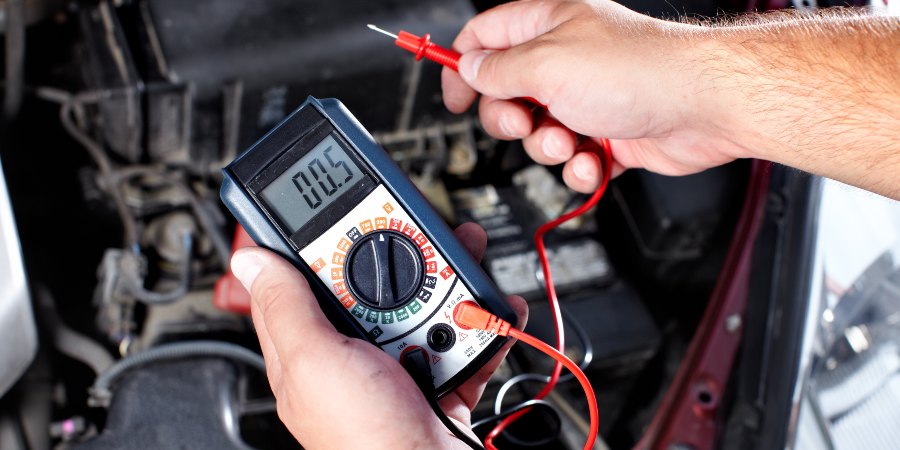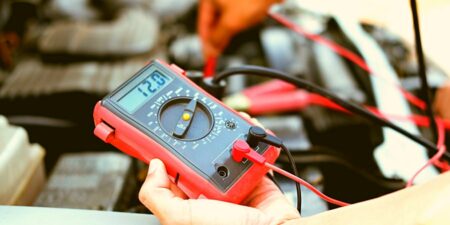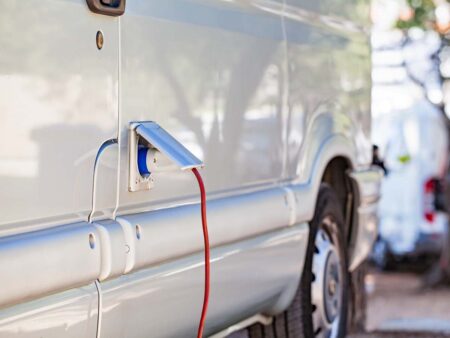Recreational vehicles (RVs) rely on electrical systems to enhance your camping experience, but have you ever wondered exactly how this electricity functions to power your adventures?
Let’s take a closer look at where electricity comes from, how it does its work, and what to do when it doesn’t work.
Basics of Electricity
- Customer Service: KAIWEETS provides a lifetime after sale service and technical support. This digital multimeter is included with…
- Multi-Function: This multimeter can test AC/DC Voltage, DC current (Can not for AC current), Resistance, Continuity, Diode…
- Sensitive Test: Please make sure the rotary switch is located at the right test range. Data hold function, backlight function…
- Safety Operation: IEC Rated CAT III 600V, CE and RoHS certified. Anti-Burn with double fuses. This multimeter has overload…
- Widely Used: The Digital Multimeter is designed to be safe and accurate, and suitable for electrician test, household use,…
Electricity is simply the movement of electrons, those little components of atoms, the basic building structure of the universe. This movement produces power we can harness to refrigerate food, run motors, illuminate lamps, and perform other useful actions.
The source of the movement typically is a power company or a storage battery. Electrical power is generated by the power company and distributed to homes and businesses via high-voltage wires.
The power is reduced at each stage until it is eventually delivered to your home or campsite as a 110-volt alternating current or VAC. (The outlet voltage delivered typically ranges from 110 to 120 volts, but commonly is called “110-volt.”)
Electricity is measured in different ways. The measurement of the flow of electrons is called current and is measured in amperes or amps (A). Voltage (V) is the pressure that moves the electrons along the wires.
Ohms (Ω) measure the resistance to the flow of electrical current through a wire or device. Think of a water hose: voltage is like the water pressure, the water in its current, and ohms are like the water flow resistance in the hose.
A larger hose — or larger wire — offers less resistance to the flow of water (current) under pressure (voltage).
110-Volt RV Electrical System
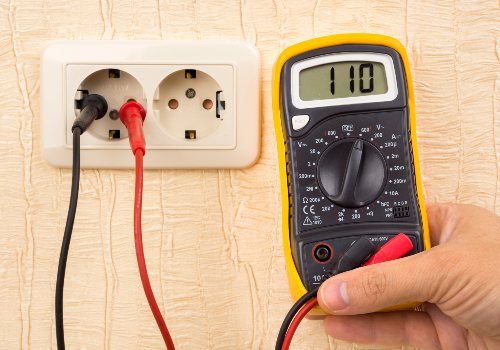
Actually, alternating current is delivered to the service box of your home using 220-volt AC electricity. The 220-volt power can be used for electric clothes dryers, ovens, and shop equipment as needed.
Most inbound electricity is then stepped down to 110-volt AC to power the lights, appliances, and gadgets in your home. Your campground probably gets higher voltage electricity and steps it down to 110-volt AC for each of the campsites.
If the campground electrical system isn’t efficient, the voltage may be dangerously high (above 132 volts) or low (below 102 volts). Excessively high or low voltage can damage or even destroy your RV electrical system.
Some electronics can’t take even that much variation in voltage. That’s why RV voltage testers are a wise investment for frugal RVers and campers. (I also keep a voltage monitor plugged into an RV outlet to easily monitor line voltage.)
If your campsite has electricity, it typically will be 20-amp (older sites), 30-amp or 50-amp service. The higher the amperage, the more current is delivered by the 110-volt AC electrical system.
As a guideline, most RV manufacturers recommend a 30-amp service if the largest electrical load is a single air conditioner and a 50-amp service for higher power needs. Note that plugging a 30-amp electrical cord into a 20-amp extension cord that goes to the electrical box or your house only delivers 20 or fewer amps of electricity.
Another popular source of RV electricity is an onboard or independent generator. RV generators typically are fueled by the engine’s fuel (gasoline or diesel) or by propane.
The output is a 110-volt AC that is delivered to the RV electrical system for use in appliances or stepped down to power 12-volt DC lights and other components.
12-Volt RV Electrical System
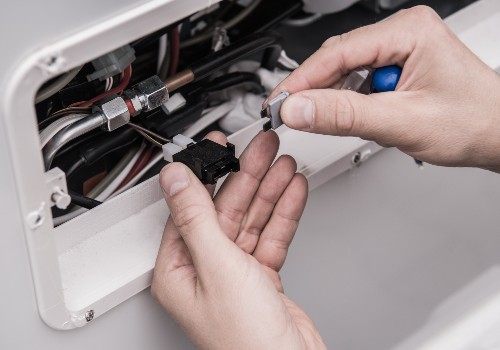
Direct current (DC) is stored in batteries for use. Most RVs use 12-volt storage batteries, though larger battery banks can be built with 6-volt batteries for storing electricity developed by solar or wind devices.
Many long-term boondockers use solar panels to produce electricity for storage in 6-volt battery banks.
Want to Connect With a Community of Over 1,078 RV Enthusiasts?
Motorhomes and van campers typically have a chassis battery for starting the motor and one or more “house” batteries for running the living quarters. (Most diesel motorhomes require two 12-volt chassis batteries for starting.)
House batteries are usually deep-cycle marine batteries or similar sources that deliver electricity longer rather than faster.
The three most popular types of RV house batteries (in order of price) are lead-acid, absorbent gas mat (AGM), and lithium-ion (LI).
RV solar power systems typically use AGM or LI batteries for longer life, but they require different chargers and operating conditions. And they are more expensive to buy.
Another source for 12-volt battery power is the RV’s 110-volt system. If plugged in, some of the 110-volt power in most RVs is diverted to a converter.
The converter converts 110-volt electricity to 12-volt electricity to power 12-volt lighting and appliances. Conversely, a 110-volt appliance with low current needs (such as a computer or LED television) can be powered with 12-volt batteries that feed current through an inverter. The inverter turns 110-volt AC electricity into 12-volt DC electricity.
Solar power is increasing in popularity with RV owners. Attached or independent solar panels are used to develop DC electricity that is stored in deep-cycle batteries, either 12- or 6-volt.
Electrical Troubleshooting
- Customer Service: KAIWEETS provides a lifetime after sale service and technical support. This digital multimeter is included with…
- Multi-Function: This multimeter can test AC/DC Voltage, DC current (Can not for AC current), Resistance, Continuity, Diode…
- Sensitive Test: Please make sure the rotary switch is located at the right test range. Data hold function, backlight function…
- Safety Operation: IEC Rated CAT III 600V, CE and RoHS certified. Anti-Burn with double fuses. This multimeter has overload…
- Widely Used: The Digital Multimeter is designed to be safe and accurate, and suitable for electrician test, household use,…
What can you do if your RV electrical system doesn’t work? Here are some suggestions:
- Tightly plug the electrical cord into the campsite service box.
- Check the electrical cord connection to the RV to make sure it is securely plugged in.
- Inspect circuit breakers and fuses inside the RV to see if they need to be reset or replaced. (Keep an extra set of fuses in your RV.)
- Securely plug the appliance into the electrical outlet.
- Inspect the appliance, as some have resets on the plug or cord.
Also, take a look at my related article on RV Electrical Tests for more information.
Learn about the Electrical System on Your RV (Video)
"Man cannot discover new oceans unless he has the courage to lose sight of the shore."
-- Andre Gide

